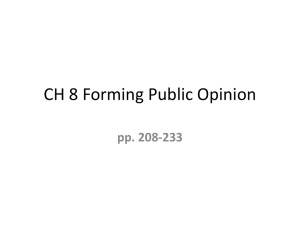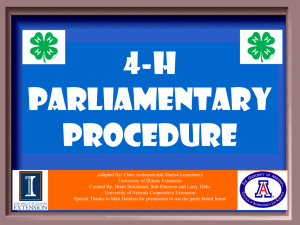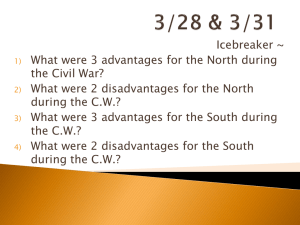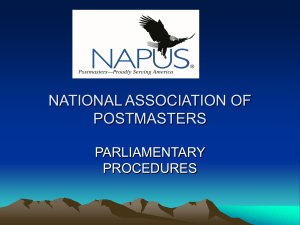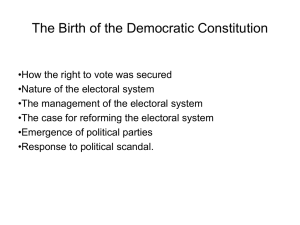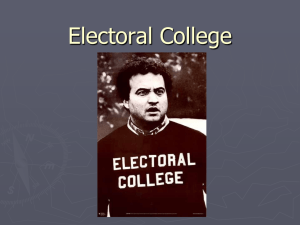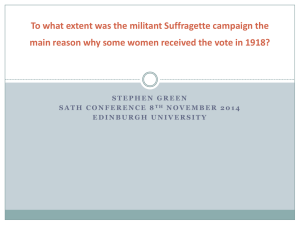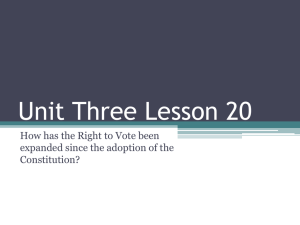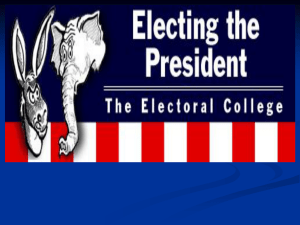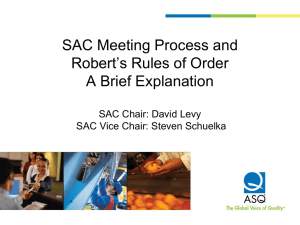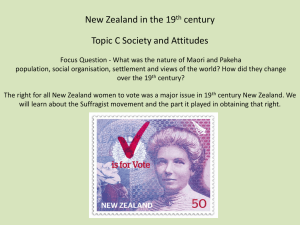Ch 10 Elections and Voting Behavior
advertisement
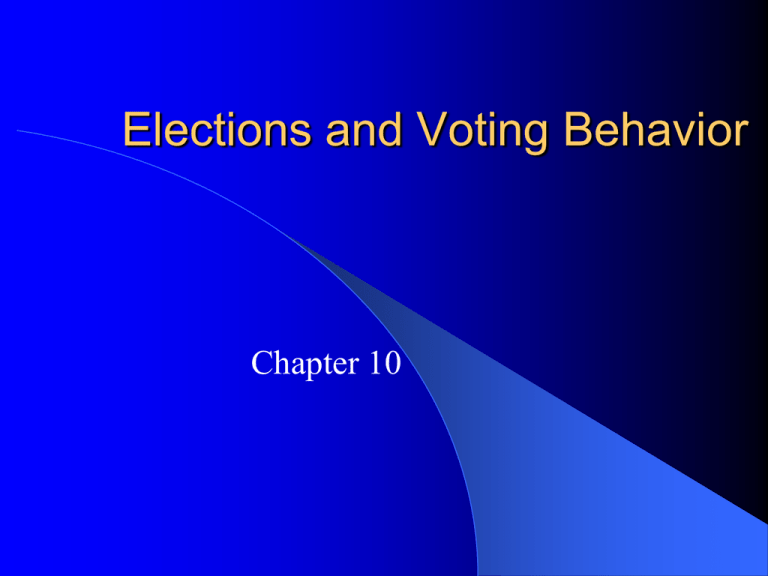
Elections and Voting Behavior Chapter 10 How American Elections Work Three types of elections: – Select party nominees (primary elections; take place in spring) – Select officeholders (general elections; takes place in Nov.) – Select options on specific policies (special elections) Special Elections & Ballot Measures Referendum: – State voters approve or disapprove proposed legislation. – Often used for constitutional amendments. Initiative petition: – Voters in some states propose legislation to be voted on. – Requires a specific number of signatures to be valid. – Can still be voted down by the people. The Expansion of Suffrage Suffrage or franchise is the right to vote It has been expanded throughout US history Today nearly all Americans over the age of 18 can vote in elections The Expansion of Suffrage 15th Amendment (1870) granted suffrage to African Americans (and other non-whites) 19th Amendment (1920) granted suffrage to women 26th Amendment (1971) set the minimum voting age at 18 (from 21) Whether to Vote: A Citizen’s First Choice Deciding Whether to Vote – U.S. typically has low voter turnouts— historically around 50% in most presidential elections. – Some argue it is a rational choice to not vote. Whether to Vote: A Citizen’s First Choice The Decline of Turnout: 1892-2004 (Figure 10.2) Whether to Vote: Registration 49 states require registration—officially signing up to vote. Registration procedures differ from state to state. Registration requirements reduce turnout – It requires voters to register well in advance of the election day. – Motor Voter Act: Requires states to permit people to register to vote when they apply for their driver’s license. Other reasons cited for not voting… Some believe there is little ideological difference between the two parties’ candidates They believe one vote among millions cast doesn’t matter They are unable to leave work on a Tuesday to vote Some reasons people are more likely to vote… They perceive an ideological difference between candidates They have a sense of political efficacy— they believe their vote makes a difference The want to perform their civic duty in a democracy Predict who is likely to vote Gender Race (Caucasian, Latino, African American) Age Education Religion (pick three) Income Urban or rural Whether to Vote: A Citizen’s First Choice Who Votes? – Education: More education = more likely to vote. Most important factor. – Age: Older = more likely to vote. – Race: Caucasian = more likely to vote. BUT, other ethnicities are higher with comparable education. – Gender: Female = more likely to vote. Whether to Vote: A Citizen’s First Choice Who Votes? (continued) – Marital Status: Married = more likely to vote. – Union Membership: Union member = more likely to vote. – Traits are cumulative - possessing several adds up. Voter Reforms Studies show that if turnout increases among groups with low rates, Democrats would probably receive more votes Republicans are unlikely to support reforms that would cost them this advantage Whether to Vote: A Citizen’s First Choice Who Votes How? Republicans – Upper income, evangelical Christians, conservative religious, Cuban Americans Democrats – African Americans, Jews, women, Latinos How Americans Vote: Explaining Citizens’ Decisions Mandate Theory of Elections – The idea that the winning candidate has a mandate from the people to carry out his or her platforms and politics. – Politicians like the theory better than political scientists do. How Americans Vote: Explaining Citizen's Decisions 1. Party Identification – People generally vote for the party they agree with. – They don’t have to become informed about every issue – This trend is declining as parties have lost some significance in the political process (with rise of Independents) How Americans Vote: Explaining Citizen’s Decisions How Americans Vote: Explaining Citizen's Decisions 2. Candidate’s Personalities – A candidate’s appearance may play an unconscious role in decision-making – People tend to value integrity, reliability, and competence. – Voters with college education are more likely to base their decision on personality How Americans Vote: Explaining Citizen's Decisions 3. Policy Preferences – People vote for candidates who share their policy – – – – preferences. Must know where they and the candidates stand on issues and see differences between candidates. Candidates can be ambiguous on the issues. Today candidates are forced to take a clear stand in the party primaries. Retrospective Voting: choosing a candidate who vows to continue policies helpful to him/her The Last Battle: The Electoral College Electoral College actually elects the President - founders wanted president chosen by the elite of the country States choose the electors Winner-Take-All system gives bigger emphasis to more populated states and swing states during campaign The Last Battle: The Electoral College How it works today: – Each state has as many votes as it does Representatives and Senators. – Winner of popular vote typically gets ALL the Electoral College votes. – Electors meet in December, votes are reported by the vice president in January. – If no candidate gets 270 votes (a majority), the House of Representatives votes for president, with each state getting ONE vote. Electoral College: Winner Take All 48 states are winner-take-all If Candidate A gets 51% and Candidate B gets 49% of vote, Candidate A gets all electoral votes In Oregon, A=7 B=0 Electoral College: Maine and Nebraska Separate vote by House district Popular vote winner in each district gets the electoral vote Winner of state popular vote gets final 2 electoral votes (show map www.270towin.c0m) 2000 Election Illustrates a key weakness to the Electoral College—winner of popular vote can lose in the E.C. Bush won more small states which are overrepresented in E.C. Gore won more populous states—they are underrepresented in E.C. Overall popular vote was close The Last Battle: The Electoral College Should the Electoral College be Reformed? Think-Pair-Share Activity Make a list of the greatest benefits and greatest weaknesses of the Electoral College system (3 of each…at least) Should the system be reformed? How? Defend your answer. Evaluating the E.C. Weaknesses – Doesn’t always represent the popular vote totals – Small states overrepresented / large states underrepresented – Faithless electors – Deflates voter turnout – Campaigns ignore some states Strengths – Winner-Take-All system provides a clear victor – Clear, Quick results – Traditional system / known quantity – Reduced risk of fraud Understanding Elections and Voting Behavior Democracy and Elections – Voters can steer government only when there are noticeable policy differences between the candidates. – Candidates who vow to continue popular policies are more likely to win elections. – Policies affect voting behavior through retrospective voting. – Bad economies make politicians nervous.

